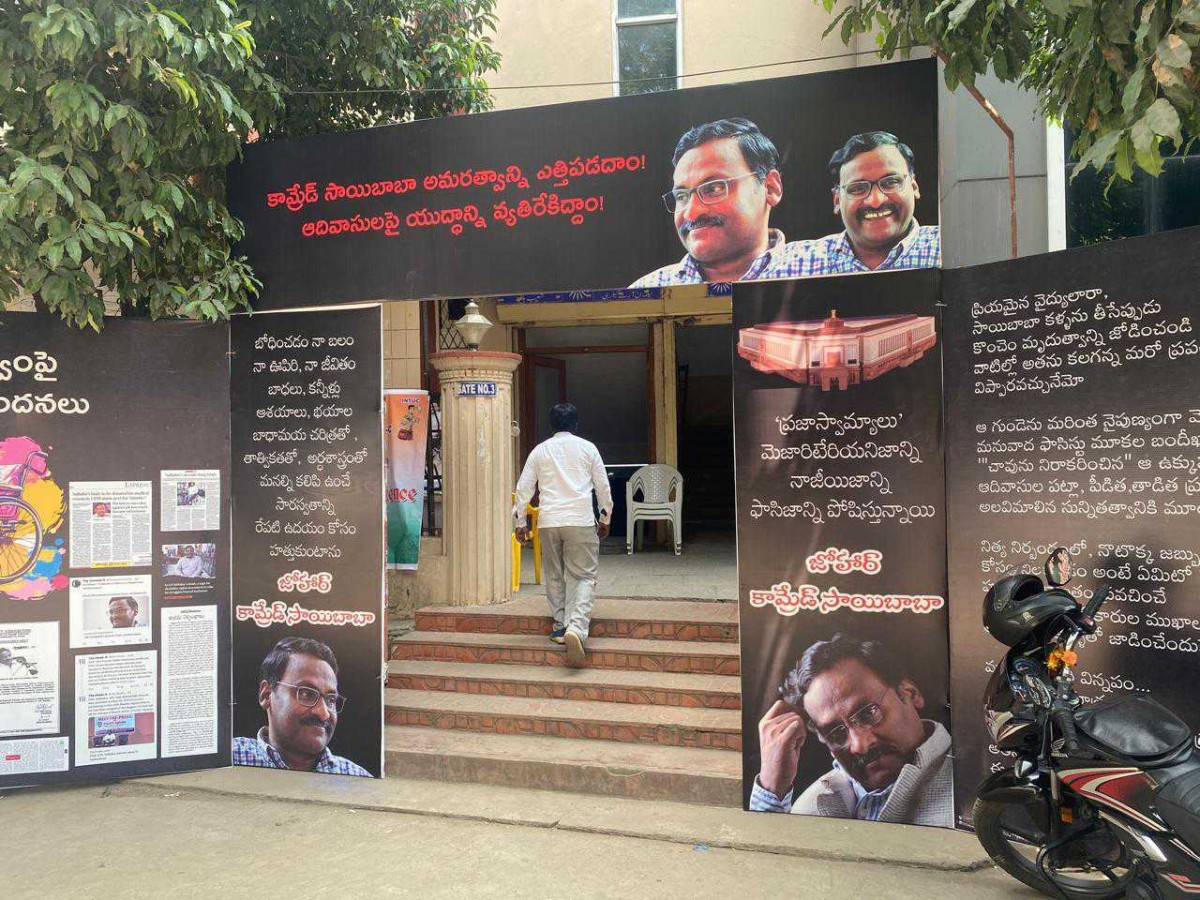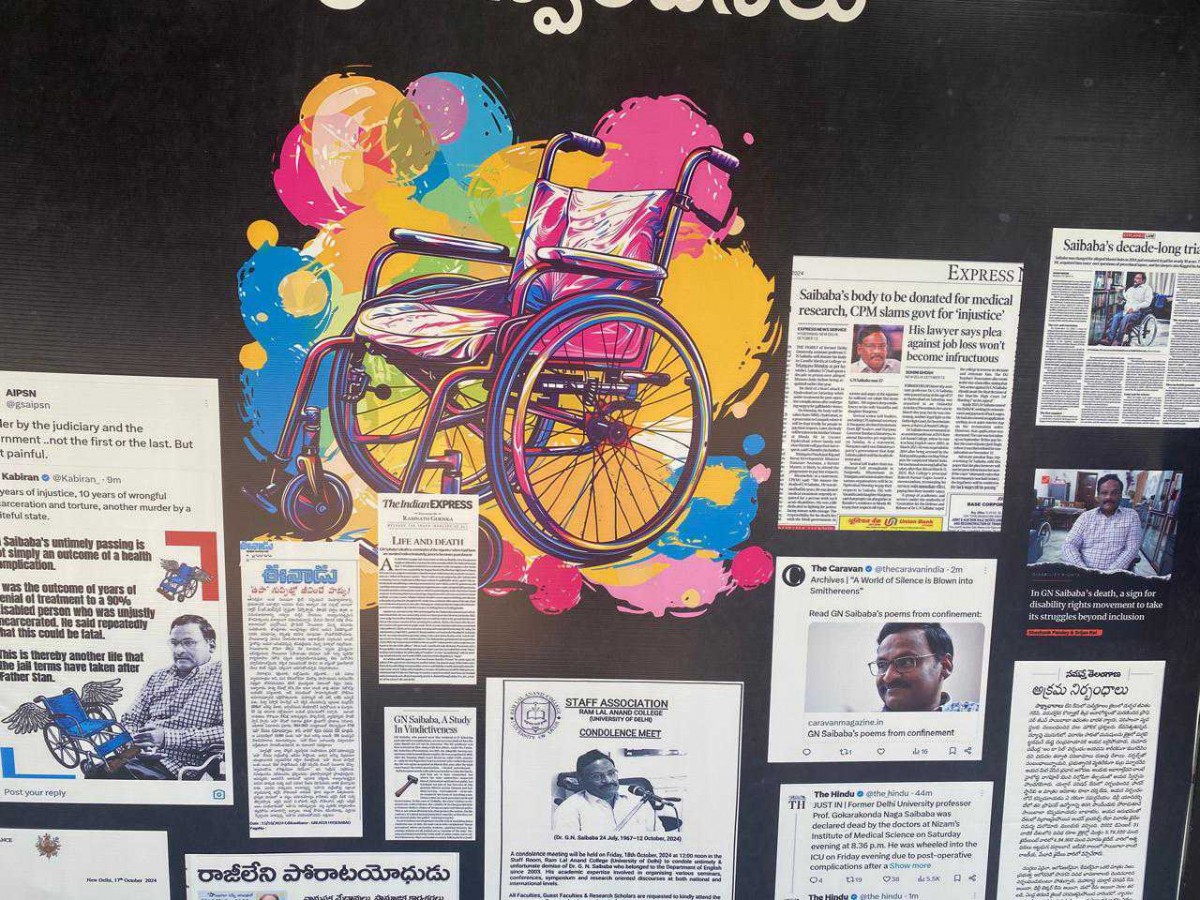G.N. Saibaba and the Community of Absence
G.N. Saibaba taught English literature for many years. His research was centred on the stories and novels of the great African writer, Ngugi Wa Thiongo.
But here I am reminded of another literary critic, Walter Benjamin. Reflecting on the modern condition, Benjamin rued that the art of storytelling has become rare. With Saibaba’s life, and the way things have transpired in the public domain, reaching ordinary people, it seems that our society too has a story to tell.
Benjamin saw that fables have the potential to stay with us all our life. Like stories from our childhood, they recommend themselves to memory and make for easy and heartfelt reproducibility.
These fables are also the lifespring of collective life. Today, we react to mostly 'shocking' events, news and incidents and try to define a “collective”, “tribe” or “community” based on such emotive outrage.
In contrast, Saibaba’s story seems to bring together everyone who hears it, without losing political poignancy. Ordinary people get teary-eyed hearing about his trials and tribulations, not least his physical disability. Rarely has someone active in revolutionary politics aroused the soul-force in people. It is a singular and unique story without being avant gardist, existentialist or individualistic.

An event organised in remembrance of G.N. Saibaba. Photo: Saroj Giri.
In Andhra Pradesh and Telangana, Saibaba’s story is already being told in songs that strike a chord in people. In the process, people are also learning about the horrors of Salwa Judum, Operation Green Hunt and Operation Kagar.
We can already see that the ‘news’ of Saibaba’s death is not exhausting itself and seems to have the power to engage us beyond the fickle news cycle. A commentator described him as a hero and many think of his life as an ‘epic’ ordeal. I am told that most newspapers in Andhra Pradesh and Telangana have not only reported the news, but also published thoughtful editorials, almost causing a slight consternation among those who narrowly identified Saibaba with only a particular political camp.
And yet, the community called up by Saibaba’s saga can only be seen as one of absence. So, no, we are not proposing the fullness and plenitude – presence – of a supposedly unalienated life one would perhaps associate with the fable and the tale.
Saibaba’s death immediately conjured up a community or a collective of mourners. His absence has turned out to be a powerful presence. The double abyss of death and incarceration that separates us from him has forged a strong sense of solidarity.
This takes us beyond the truism that only in death do we know the worth of a life lived. We had very little idea that such a potential community lay unexplored, waiting to come to light. We then find ourselves rather serendipitously in the midst of a commune-to-be.
Death, the absence, the loss produces a community of infinite immanence. It is through the abyss of such an effervescent death, that we relate to each other. Community as a work of death, as philosopher Maurice Blanchot would say. Saibaba now appears as one “whose living and closest presence is already an eternal and unbearable absence”.
We find an inner strength in the intimacy of this absence and loss.
Interestingly, the Supreme Court, in trying to criminalise Saibaba, had added a coat of effervescence. By indicting him as the “brain”, he was simultaneously condemned and elevated. The court had already forced a transcendence on him by declaring such a frail and slow moving body as his, to possess a dangerous brain.
Such valorisations, including the community of absence, allows us to eulogise Saibaba without having to engage with the politics he upheld. We are then left to wonder if calling him a “human rights activist” might be tailored to such asinine eulogies that preclude any critical engagement with the man and his work.
Some people are now packaging Sai’s death as 'yet another example' of the repressive character of the ruling regime, their cruelty and what not. This seriality of examples of state repression resembles a ruse to not engage with the specifics of his case, skimming the surface forever. We saw several politicians lining up to pay their respects at Saibaba’s funeral in Hyderabad – some of whom had to be literally shown the door.
This privilege and luxury of associating or distancing oneself with the politics of Saibaba is absolutely noticeable here — not just by politicians but also by progressive activists of all hues.
Let us unpack things a bit.
This contingent relation between the politics of Saibaba and his eulogised figure is in fact sustained by the lacerated and contorted body of the feral Adivasi who resisted the depredations of big capital. This Adivasi in fact stands for the figure of the revolutionary militant in his/her abject destitution and being-towards-death, whose global paradigm today is perhaps the Palestinian militants fighting in the trenches of Gaza.
Indeed the Adivasi and the militant are not just suppressed from view as an effect of power, but are in fact intrinsically incommunicable, as though forever impervious. We are reminded of how Frantz Fanon emphasised the near-impossibility of understanding “the being of the black man”.
This imperviousness is related to what the black scholar Fred Moten calls the “undercommons”, the underground black maroon republic, akin to the “janatana sarkar” of Adivasis in Bastar and Gadchiroli — Gadchiroli being the mining belt from where police officers first came to raid Saibaba’s university residence in September 2013.

Newspaper cuttings at an event organised in remembrance of G.N. Saibaba. Photo: Saroj Giri.
This imperviousness and incommunicability is of course already anticipated when Marx in Capital uses the expression “hidden abode of production” to grasp the logic of capital more generally — the use of “hidden” being by no means incidental. For that matter, the recent work of Achilles Mbembe on necropolitics also speaks to what we are trying to grasp here.
So the media and cultural machine, which valorises Saibaba, will do very fine without engaging with these impervious undercommons. It refuses to confront the fact that the “brain” is nothing without the Adivasi. In a supremely Brahminical or idealist move, the court which gave the judgement would want to suppress and forget this Adivasi and portray Saibaba as the great “conspirator” or “mastermind”.
Effectively, then, the court indicted Saibaba to keep him in jail, but also left open, as though through the backdoor, the possibility of his counter-cultural or radical valorisation later. This opens the way towards an uncritical celebration of Saibaba. The system took away his life and liberties but committed a far deeper structural violence on the Adivasi — one which, at a discursive level, might very well be continued by the progressive activist mourning his death.
We must ask: how does one move beyond not just the specific denial of liberty by the state and the courts, but also the entrenched framework at play? We find ourselves exposed to the kind of threat and risk faced by Saibaba, but in a way which obviously distances us from the far more precarious Adivasi and revolutionaries in whose name the politics is upheld. Are we then just entrenching our own social positioning?
Extra-judicial violence is often seen as coming from the top but, seen from below, we realise that the way we engage or narrativise the risk it exposes us to, is mediated by our social, class and caste positioning. So yes we have the entire gamut of equally effervescent relations of big capital, the Indian deep state, the National Investigation Agency and the Unlawful Activities (Prevention) Act. And yet we must be aware of the narrative we are weaving to focus on these structures of violence and our exposure to risk and death.
So how do we remember Saibaba today?
We must recall names like Gudsa Usendi, Sodi Sambo, Hidme Markam and Soni Sori. The massacres in Sarkeguda, Eddesmetta and Gompad. The resistance in Silger, Modonar and Bechapal. The quiet and relentlessly extractive work of big capital a ka Jindal, Essar, Tata, Adani, et al.
The community or collective occasioned by Saibaba’s death and the double abyss, the double absence and intense loss, sits in such an uncomfortably contingent relationship, almost a disjunction, with politics and the struggle. One is therefore bound to feel a deep isolation which comes from not having roots among the masses. Mourning can then give way to melancholia and a kind of powerlessness which might partly be our own inability to experience loss beyond the limits of our social standing.
The community of absence, of intimacy, which embraces human relations in the outer limit of death, points towards a society which is not based on the rule of property and surplus accumulation. This is a community which subsists forever on the verge of its own disappearance, as Blanchot would have it. The community of absence might have been an immediate protuberance in the light of Saibaba’s death, but we can see that it signifies the modality for a new kind of society.
The community of absence however must come to terms with the destitution of the Adivasi and the revolutionary militant in action. Saibaba is the name of this interrelationship. The very bright ray rarely escaping the impervious and incommunicable world of the Adivasi is what Saibaba sought to embrace. That is what illuminates him.
Saroj Giri teaches Politics in University of Delhi and is part of the Forum Against Corporatization and Militarisation (FACAM).
The Wire is now on WhatsApp. Follow our channel for sharp analysis and opinions on the latest developments.




